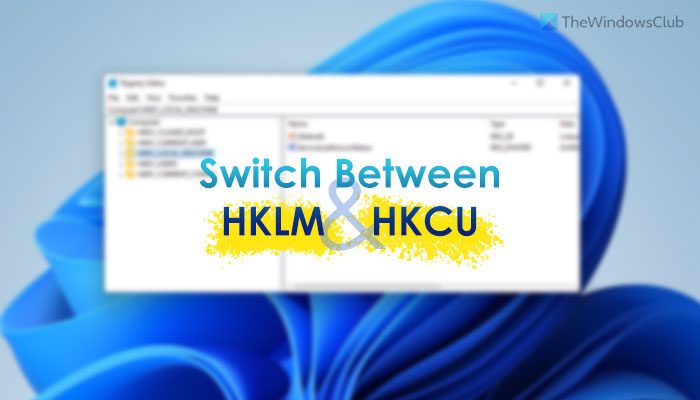Difference between HKLM and HKCU
HKEY_LOCAL_MACHINE is abbreviated as HKLM, whereas HKEY_CURRENT_USER is abbreviated as HKCU.
If you have multiple users on your computer, and you want to apply a setting for all the users at once, you need to make the change in the machine-level HKEY_LOCAL_MACHINE key.If you want to apply a change to the current user account only, you need to use the user-level HKEY_CURRENT_USER key.
For example, if you want to prevent all users from installing extensions in Edge, you need to create the value in HKEY_LOCAL_MACHINE. But, if you want to stop the current user or the account you are logged into, you need to create the same value in HKEY_CURRENT_USER. In most cases, an identical value can be created in both places, i.e., HKLM and HKCU. However, in some cases, it is not possible to do that. Now let’s say you want to create or find the same key/sub-key in HKLM as well as HKCU. As Registry paths could be long and complicated, you can follow this tip to switch from HKLM to HKCU or HKCU to HKLM quickly in Registry Editor. The best thing is that Windows operating system includes an option in the Registry Editor itself. Some of you may want to read this post on Windows Registry Basics.
Switch between HKLM and HKCU Registry keys
To switch between HKLM and HKCU keys, or vice versa, quickly in Registry Editor, follow these steps: First, you need to open the Registry Editor on your computer. For that, press Win+R, type regedit, hit the Enter button, and click on the Yes option in the UAC prompt. Next, you need to find the key in the HKEY_LOCAL_MACHINE that you want to find in HKEY_CURRENT_USER. Right-click on the key/sub-key and select the Go to HKEY_CURRENT_USER option.
The Registry Editor will redirect you to the same path in HKEY_CURRENT_USER. Similarly, if you want to switch from HKCU to HKLM, you will see Go to _HKEY_LOCAL_MACHINE option when you right-click on a key/sub-key.
Does HKCU override HKLM?
No, HKCU doesn’t override HKLM. If you make a change in HKCU, it will be applied to the current user only. However, if you apply for a change in HKLM, it will apply to the entire computer. That being said, HKLM overrides HKCU in Registry Editor. However, it depends on other external factors as well.
How do I get into HKCU registry?
To get into HKCU in the Registry Editor, you need to open it first. For that, press Win+R > type regedit > press the Enter button > click the Yes option. Then, you may need to expand the Computer section. Here you can find five different sub-sections, and one of them is HKEY_CURRENT_USER.
How do I change the path in the Registry Editor?
There are multiple ways to change the path in the Registry Editor. For example, you can manually navigate to different keys to find the desired one. You can enter a path in the Registry address bar or use this tip if you want to find a similar HKLM key in HKCU or vice versa. Read: How to monitor and track Registry changes in Windows.

